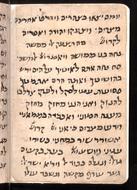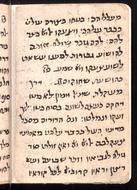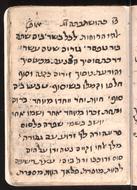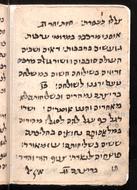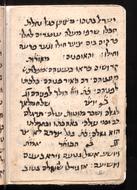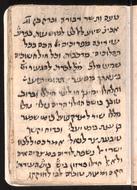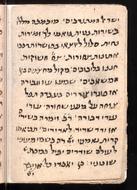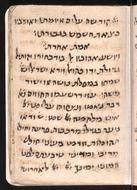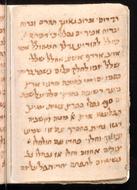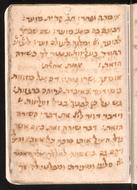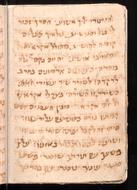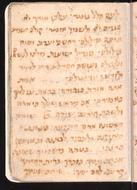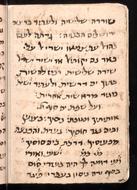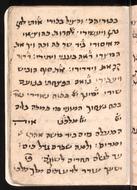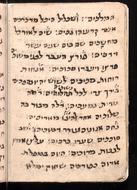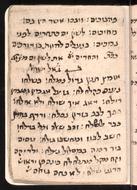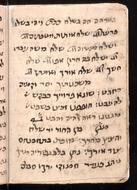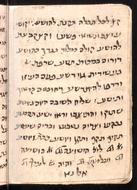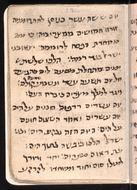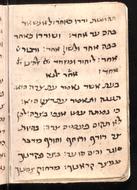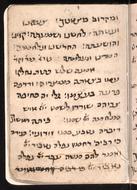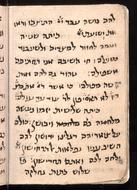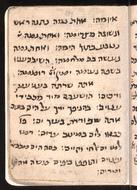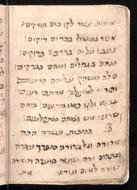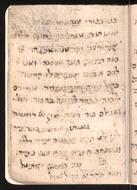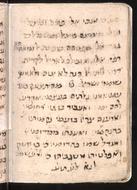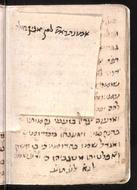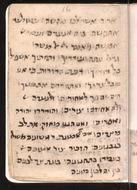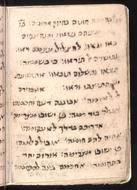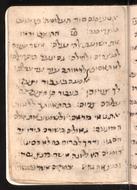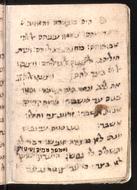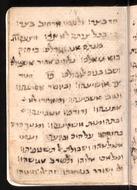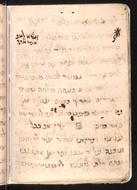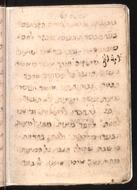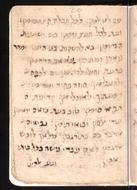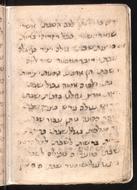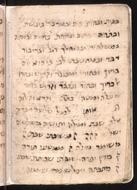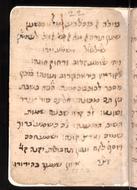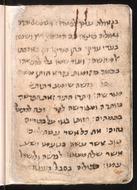Halper 253 Collected piyutim for the seventh day of Passover
Title
Collected piyutim for the seventh day of PassoverCall number
Halper 253(Philadelphia, United States, University of Pennsylvania, Center for Advanced Judaic Studies Library, Cairo Genizah Collection)
Alternate identifiers
Publisher
Center for Advanced Judaic Studies LibraryLanguage
HebrewOrigin
12th century-14th century?
- Place
-
Orient
Notes
- Verse endings denoted by a sof pasuḳ; From either a Yotser for either the Seventh day of Passover, or the weekly seder reading of Be-shalaḥ (Ex. XIII-XV):;A. (fol. 1) The last eight strophes (ה-צ) of אומן שר למחזק זרועו by Joseph Albaradani; B. (fols. 1-2) אשורר שיר במחני. Six verses (א-ו); C. (fol. 2)(כהושעת שחוקים (..אז בנוף בארץ מגורתינו. Six strophes (א-ו); D. (fol. 3) Heading: אופן. A pair of piyyutim, both constructed of 6 three-verse strophes (א-צ) the first starts אלהי הרוחות, the second אופני מרכבה במרומי ערבות. The acrostic signature in the combined refrains read חיים בן שלמה; E. (fol. 4) Another Ofan, אין אל בלעדו. Each word is arranged alphabetically, every other word rhymes - דו. The acrostic reads א-ת שלמה; F. To be inserted before Maorot: אראלם שוררו, three strophes of three rhyming verses each (א-צ), the acrostic continues in קדושים כראו בעיניהם positioned before Yotser (verses ק-ר), and שלח מלאך לגאלם before ha-bo.her (verses ש-ת); G. (fols. 4-6) Under the heading אמת, the Zulath, ויושע אשל נטעם, 7 four-verse strophes, the first three of which rhyme, and are ordered א-ק, the fourth rhymes בים- and its acrostic reads שלמה חזק; H. (fols. 6-7) Under the heading אמת אחרת, an alternative Zulath, אהוביו אל ביד בחירו יקותיאל, the same scheme as the previous one, the acrostic of every fourth verse reads שולימאן, indicating that this and the previous are by Solomon Suleiman; I. (fols. 7-8) Under the heading אמת אחרת, an alternative Zulath, אומצך שרו נותני דם, 7 three-verse strophes, ordered א-ק. The refrains are verses from II Sam XXII, which is the Haftarah for the seventh day of Passover; J. (fol. 8) Headed אמת, an alternative Zulath, אתה אזרת בגבורה, three strophes (א-ג). See parallels in other ms. sources by E. Fleischer: Yotserot be-hithaṿutam ve-hitpatḥutam. Jerusalem : Magnes, 1984, p.300-301; K. (fols. 8-9)אותותיך ומופתי נסיך , three verses (א-ג) followed by the Mi kamokha, מי כמוך ישעי ואורי by Joseph Albaradani, monorhymed - רי , the acrostic signature reads יוסף אלברדאני; Published by T. Beery: ha-Ḥazan ha-gadol asher be-Bagdad / Tova Beeri. Jerusalem : Makhon Ben-Tsevi, 2002, p. 439; L. (fols. 9-10)The Adonay Malkenu, איה המעלם מים, four rhymed lines followed by ישעך עורר לדעוכים, 22 verses monorhymed - כים, the acrostic signature reads יושף אלברדאני; in Beery, ha-Ḥazan, p.440-441; The Ḳedushta for the reading of Be-shalaḥ:;M. (fol. 10) The Magen אומץ תנין גדול נמלח, twelve verses (א-ל) monorhymed - לח, followed by four verses that rhyme - בט, starting משכנותיך יסד וקמים החבט; in Beery, ha-Ḥazan, p.443-444; N. (fols. 10-11) The Meḥayeh מן החור יד שלח, twelve verses (מ-צ) monorhymed - רך, followed by four verses that rhyme - פניו, starting שמו איחד כצבא אופניו; O. (fol. 11)קץ לכל תכלה תקנת, 12 verses (ק-ת, with the addition of the acrostic signature in verses 2-3, 6-7: יושף, monorhymed - שע;P. (fol. 12)יום ששה עשר בניסן, four strophes of varying size. Republished, along with parallel ms. sources, by T. Beeri, Matsdarim ṿe-yotsrot be-fiyuṭe Yosef Albaradani (Doctoral dissertation). Jerusalem : Hebrew University, 1999 p. 347-8; Q. (fols. 12-13)בעת אשר נאמר עת צרה היא. Listed by M. Zulay (Yediọt ha-makhon le-ḥeḳer ha-shirah ha-ʹIvrit, v. 2 (1936), pp. 287, 367) as an element from a Ḳerovah of Yannai for the Erets-Israeli seder of Ex. XIV, republished as such in Piyuṭe Yanai. Berlin, 1938, p. 97 no. 43 (index p. 430), and again by M. Rabinowitz, Maḥazor piyuṭe Rabi Yanai la-Torah ṿela-moʹadim, 1985 / Zvi Meir Rabiniwtiz. Jerusalem : Bialik, vol. I, p. 308; R. (fols. 13-14)אמנם שלוש כתות, four three-verse strophes (א-ל) followed by its refrain: שלש כתות נחלקה, five verses, rhymed - מה; S. (fol. 14)אתה שרת בעני עמך, one three-verse strophe (א-ב), and the first two strophes (מ-ע) of מכות עשר לקו בים; republished from this, and parallel ms. sources, by Y. Yahalom, Piyuṭe Shimʹon bar Megas, 1984 pp. 196-197, where the former appears as an element in a piyyut for the reading of Ex. XIV 15, attributed to bar Megas (the identification of the former, is dubious, appears in the appendix, ibid p. 275); The complete piyyut has three more strophes (פ-ת). Each of these is followed with their respective refrains כבאו לים במיטב עדים, and מהם שרופי אש; T. (fol. 15) In the same scheme as the previous, (את בני בכורי אנהגהו (א-ב and (געיתו אשמע בעת צרה (ג-ד, republished by Y. Yahalom, ibid. p. 274, possibly attributed to Shimʹon bar Megas; Each are followed by its respective refrain מה תצעק בעד איומה , and מה תצעק יקותיאל (republished, along with parallel ms. sources, by T. Beeri, ibid. p. 409) and מה תצעק בעד עמי. Also found in no. 252(A-B) in a different arrangement; U. (fol. 16)ארור אשר לבו מקשה, three three-verse strophes (א-ה). Inserted in the space following this piyyut, is a reference to [איבי [נחל עדני (supplemented from parallel ms. material in the Ginze Shekhṭer publication, p. 139); V. אמונת ראשונים משולי גבנונים, and its refrain עיניהם נשאו והנה צרים באו. Also found in no. 252(P) (Ginze Shekhṭer, p.105) where two additional verses are attached; W. (fols. 16-17)(אאמירם לי לאיומה(א-ת, and its refrain התיצבו וראו את ישועת אלהי עולם. Both also appear in no. 252(D) (Ginze Shekhṭer, pp.54-55); X. (fol. 17) Verses א-ד of אמנם בעבור יצעקו. Listed by Zulay (Yediot ha-makhon II, 1936, pp. 287, 367) as an element from a Ḳerovah of Yannai for the Erez-Israeli seder of Ex. XIV, republished as such by M. Rabinowitz, Maḥazor piyuṭe Rabi Yanai la-Torah ṿela-moʹadim / Zvi Meir Rabinowitz. Jerusalem : Bialik, 1985, vol. I, pp. 308-309, where verses - are added from parallel ms. sources; Followed by its refrain הים מפניהם והאויב מאחריהם. Both are also found in no. 252(E) (Ginze Shekhṭer, pp. 55-56); Y.(fols. 17-18) את לבב עמי מה תשבר(verses א-ו,מ-נ) Published from this, and parallel ms. sources, by Y. Yahalom, ibid. pp. 198-199, where it appears as an element in a piyyut for the reading of Ex. XIV 15, attributed to Shimʹon bar Megas. Verses א-ו are also found in no. 252(F) (Ginzei Schechter p. 56). Followed by its refrain מיד צר אושיעהו, verses 2-8 appear in the anonymous collection of short poems (Cambridge Add. 3663) published by E. Fleischer, Pizmone ha-Anonimus, 1974, p. 154 no. 203; Under the heading ובכן יאמר הנני ממטיר, a Ḳedushta by Shimʹon bar Megas for the weekly seder reading of Hineni Mamtir that starts Ex. XVI 4; Z. (fols. 18-19)מדה במדה תמוד נכוחה, two four-verse strophes (מ-ע), (Yahalom, ibid. pp. 200-20). Followed by its refrain צדק אב בכל עניניו, which appears in the anonymous collection of short poems published by E. Fleischer, ibid. p. 156 no. 206; AA. (fol. 19) Under a headline suggesting the melody of יוסף מני פנה, three rhyming verses אדון דברו לא שינה (Yahalom, ibid. p. 201). Followed by its refrain כטעמו טעמו ערב לכל טועמו (E. Fleischer, ibid. p. 156 no. 207); BB. אמונת רועינו לא נחסר (Yahalom, ibid. p. 275, possibly attributed to Shimʹon bar Megas). Followed by its refrain עדת צנועים נתכלכלו ארבעים ( E. Fleischer, ibid. p. 156 no. 208); The following are possibly from a Ḳedushta for the next seder reading ʾAd Ana (Ex. XVI 28); CC. (fols. 19-20)מתוקים חכך אשר מאמרו נעשה (Yahalom, ibid. p. 201)appears here after a contracted headline suggesting a melody ל[חן] קד[וש' אי]לף' Solomon Suleiman's Qiqlar for Passover). Followed by the refrain מה תצעק אומן אומן, 18 verses rhymed מן-. The The acrostic signature formed by verses 2-3-5-7-9-10 reads אלכופי (Solomon al-Kufi Hazzan, see Haberman: Be-ron-yaḥad / Abraham Meir Habermann [ed.]. Jerusalem : Mosad ha-Rav Ḳuḳ 1945, p. 35); dd. (fols 20-21) The Rahit אשרי שומרי שבת, followed by יום מנוחה הוא ליעף and למול שלשה דברים אלה. All are listed by Zulay (Yediot ha-makhon II, 1936, pp. 287, 367) attributed to Yannai; republished from this and parallel ms. sources, by Zulay, Piyuṭe Yanai, 1938, pp. 98-99 n. 44; (fol. 22) From the Ḳedushta for the seder reading Ṿa-yishmaʹ Yitro; EE. Heading: שילשול וישמע יתרו. The Shilshul ויהי] שומע קרוב ורחוק חונה], The acrostic signature reads שלמה חזן; FF. Heading: יוצר. The first 6 two-verse strophes (א-כ) of the Yotser אזון שמעך בהדורו by Solomon Suleiman.
- Condition: consecutive, complete; faded, particularly from fol. 18 verso and onwards.
Extent
13.7 X 9.5 cmSupport
PaperLayout
Decoration
Material applied: black ink
Script
Provenance
- Cairo Genizah Collection (University of Pennsylvania. Center for Advanced Judaic Studies. Library).
- Cairo Genizah Collection (Dropsie College. Library).
- Adler.
Subjects topical
- Piyutim
Licenses
-
- Text
- These images and the content of Center for Advanced Judaic Studies Library, Halper 253: Collected piyutim for the seventh day of Passover are free of known copyright restrictions and in the public domain. See the Creative Commons Public Domain Mark page for usage details, http://creativecommons.org/publicdomain/mark/1.0/.
- URL
- http://creativecommons.org/publicdomain/mark/1.0/
-
- Text
- Metadata is ©2017 University of Pennsylvania Books & Manuscripts and licensed under a Creative Commons Attribution License version 4.0 (CC-BY-4.0 https://creativecommons.org/licenses/by/4.0/legalcode. For a description of the terms of use see the Creative Commons Deed https://creativecommons.org/licenses/by/4.0/.
- URL
- https://creativecommons.org/licenses/by/4.0/legalcode


